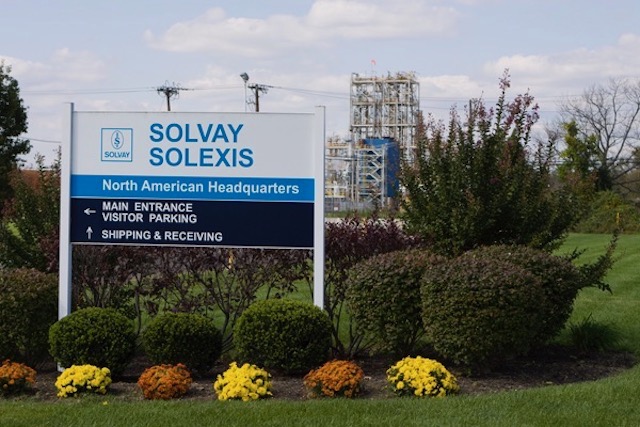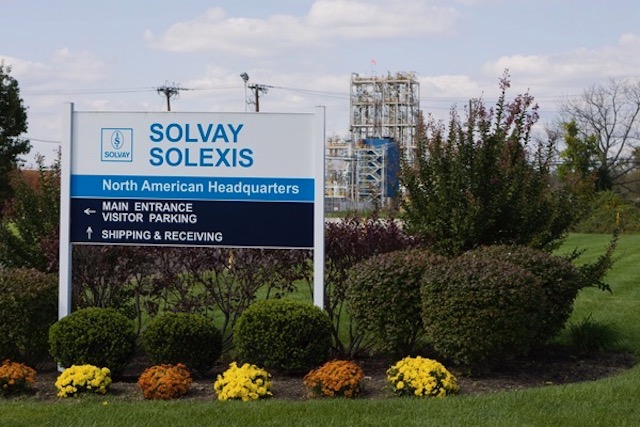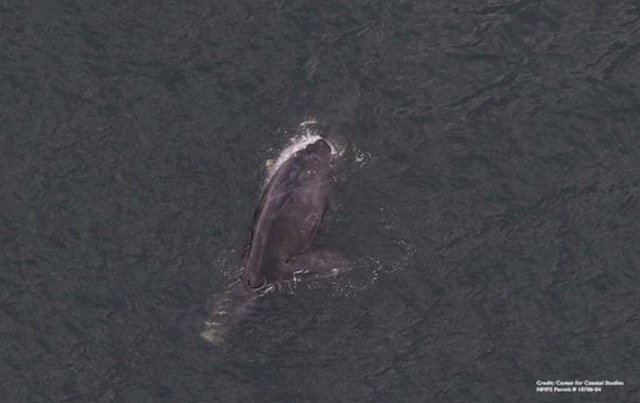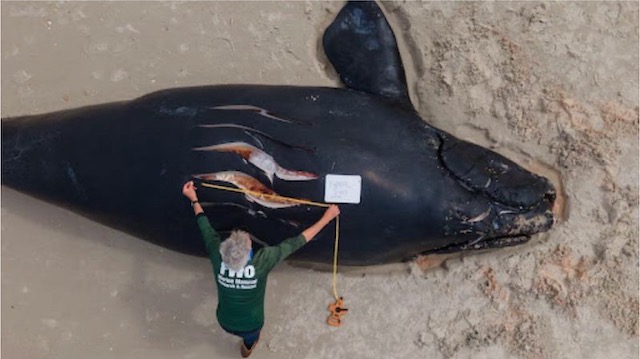Murphy DEP Privatizes Cleanup Of Solvay Corporation’s Toxic “Forever Chemicals” Contamination
DEP Allows Solvay’s Private Consultant To Control Cleanup
Solvay Has Concealed Information, Violated DEP Regulations, And Delayed Complete Cleanup For Over A Decade
NJ Toxic Site Cleanup Law Calls For Direct DEP Oversight Of High Risk Sites, Particularly Those Created By Recalcitrant Corporate Polluters Like Solvay
29. Immediately following the Effective Date, the Department shall adjust the Direct Oversight requirements for the Site, and Solvay shall conduct the remediation described in the JCO under the oversight of an LSRP in accordance with the terms of this JCO, (proposed settlement, @ page 27-28)
The Murphy DEP has put Solvay in charge of protecting public health and the environment. Solvay is given control over collecting and analyzing data; preparing and selecting the cleanup plans; and controlling critical information, despite their atrocious record.
The DEP’s proposed settlement that delegates these critical powers to Solvay directly contradicts NJ’s toxic site cleanup laws.
Let me explain those harsh claims, and in detail.
There is no question that South Jersey’s toxic “forever chemicals” PFNA polluter Solvay is not a responsible corporation, in terms of how they’ve managed the production, discharge to the environment, and cleanup of the class of toxic chemicals PFNA, commonly known as “forever chemicals”.
Solvay has: 1) concealed information from EPA and DEP regulators, local governments, water utilities, and the public, 2) evaded and violated DEP regulations, 3) poisoned drinking water, soil, groundwater, natural resources and people’s bodies; and 4) delayed complete cleanup for over a decade.
This long standing pattern of secrecy, negligence, evasion, willful non-compliance, and obstructionist foot dragging is well known by US EPA and NJ DEP and documented in many news media stories.
Solvay shoved secrecy demands down DEP’s throat in response to a DEP enforcement directive:
Even former corporate lawyer and current Murphy DEP Commissioner LaTourette just blasted Solvay for their intransigence: (NJ Spotlight)
‘It should not have to take a years-long enforcement action to bring a responsible party to the table. But if that’s what it takes, that’s what we will do.’ — Shawn LaTourette, DEP commissioner
If it took years to bring Solvay to the table and secure enforceable commitments to comply with DEP regulations and cleanup the toxic mess Solvay created, why on earth did DEP’s proposed settlement of a lawsuit seeking enforcement of DEP regulations allow Solvay to control the cleanup of their toxic mess?
LaTourette’s slam was widely reported nationally: (NBC News):
LaTourette said that, for years, Solvay “rebuffed” his department’s requests for environmental clean up. Yet, he said, only after years-long efforts to get the company to address these chemicals, and legal action, did Solvay take action that will help clean up the environment.
“It should not take that much,” he said, noting that the state’s efforts weren’t intended to only protect the environment. “We protect our environment in order to protect people’s health.”
The legal community, Law.com reported:
in November 2020, the DEP filed suit against Solvay and alleged that, “despite evidence of widespread contamination” at the West Deptford site, the company ”has repeatedly refused to comply with plaintiffs’ numerous directions to investigate all contamination from the Site and to pay for the treatment of all contaminated drinking water.” …
“For years, corporations, including Solvay, have put financial gain over our clean drinking water and the health of millions of people,” stated Platkin. “They have blatantly ignored the dangers posed by the PFAS ‘forever’ chemicals that accumulate in our environment and in our bodies. New Jersey has pursued those who thought they could leave their mess to someone else to clean up.”
And I found this quote from the Inquirer story particularly sickening, because I loved my grandmother who would never lie or sell out:
“We should all do what got my grandmother impressed upon me as a kid, which was to leave a place better than you found it,” LaTourette said. “That is the obligation of Solvay and every actor whose activities contaminate our environment. … It should not have to take a years-long enforcement action to bring a responsible party to the table. But if that’s what it takes, that’s what we will do.”
I loath this hypocrite.
Given this history, why are there no mandatory public disclosure, public participation, and public records law (OPRA) requirements in the proposed settlement, given this corporate pattern of secrecy? Why did DEP allow Solvay to control information? Here is the LSRP regulatory status -(see page 5)
An LSRP’s data and records are not “public records” as defined in the Open Public Records Act (OPRA), N.J.S.A. 47:1A-1 et seq. As a result, an LSRP has no obligation under OPRA to provide the public with access to his or her records. An OPRA request for such records is available after the LSRP has submitted them to the Department along with a response action outcome. Until that time, the person interested in such records will have to contact either the LSRP or the person responsible for conducting the remediation to gain access to those records.*
This is highly irresponsible, bordering on insane.
NJ’s Site Remediation law explicitly requires DEP direct oversight of sites that are highly complex, pose high risk to public health and the environment, or where a recalcitrant polluter is responsible for the mess.
The NJ law establishes two types of direct DEP oversight. There are contaminated sites where the law mandates direct DEP oversight (“shall”) and situations where the law allows DEP to assume direct oversight (“may”). Both situations apply with respect to Solvay, so DEP is clearly violating NJ cleanup laws and not appropriately exercising discretion in the proposed settlement.
Here is the applicable legal text. (emphases mine)
58:10C-27. Direct oversight of remediation by department; conditions
a. Except as provided in section 1 of P.L.2013, c.283 (C. 58:10C-27.1), and this section, the department shall undertake direct oversight of a remediation of a contaminated site under the following conditions:
(1) the person responsible for conducting the remediation has a history of noncompliance with the laws concerning remediation, or any rule or regulation adopted pursuant thereto, that includes the issuance of at least two enforcement actions after the date of enactment of P.L.2009, c.60 (C.58:10C-1 et al.) during any five-year period concerning a remediation;
(2) the person responsible for conducting the remediation at a contaminated site has failed to meet a mandatory remediation timeframe or an expedited site specific timeframe adopted by the department pursuant to section 28 of P.L.2009, c.60 (C.58:10C-28), including any extension thereof granted by the department, or a schedule established pursuant to an administrative order or court order; […]
b. The department may undertake direct oversight of a remediation of a contaminated site under the following conditions:
(1) the contamination at the site includes chromate chemical production waste;
(2) the department determines that more than one environmentally sensitive natural resource has been injured by contamination from the site;
(3) the site has contributed to sediments contaminated by polychlorinated biphenyl, mercury, arsenic, or dioxin in a surface water body; or
(4) the site is ranked by the department in the category requiring the highest priority pursuant to the ranking system developed pursuant to section 2 of P.L.1982, c.202 (C.58:10- 23.16).
Even DEP admits this. According to DEP: (emphasis mine):
Direct Department Oversight – Sites that are not in compliance with Department regulations, or violate a mandatory timeframe are subject to direct Department oversight. Direct Department oversight requires the remediating party to establish a remediation funding source in the amount equal to the total cost of the remediation, and involves a much higher level of Department control over the remediation, which is much more onerous than for sites that are being remediated with LSRP oversight.
1) It is baffling that DEP allowed Solvay to conduct the sampling and cleanup under the control of a private consultant, known as an “LSRP”, for Licensed Site Remediation Professional. This is exactly the kind of high risk site and major corporate polluter noncompliance and negligence that should trigger mandatory direct DEP oversight. It is absurd for DEP to continue to privatize the cleanup of a site that DEP had to file a lawsuit to enforce existing cleanup regulatory requirements.
Here are just two key examples of that, which is repeated multiple time throughout the proposed settlement for virtually all requirements DEP imposed: (@ page 23)
“To the extent that cC6O4 is identified in the environment as a result of the delineation performed in accordance with Paragraph 21(b), Solvay’s LSRP shall provide the Department with a report that evaluates whether the PFNA, PFOA, and Alternative PFAS clean-up and drinking water treatment activities required by Paragraphs 14 through 16 will result in the clean-up of cC6O4;”
[…]
29. Immediately following the Effective Date, the Department shall adjust the Direct Oversight requirements for the Site, and Solvay shall conduct the remediation described in the JCO under the oversight of an LSRP in accordance with the terms of this JCO, (@ page 27-28)
DEP has put Solvay in charge of public health, despite their atrocious record.
2) This provision is disgraceful – DEP promises to work hard to comment on Solvay’s work, with deadlines!! And notice that there is no PUBLIC COMMENT on Solvay’s work:
“34. The Department shall make good faith efforts to provide comments to Solvay’s LSRP on the documents specified in Paragraph 33 or to approve such documents (in accordance with its statutory and regulatory obligations) within 120 days of receipt by the Department.”
3. Holy shit! The DEP relieved Solvay of important regulatory requirements and delegated the complete control of the cleanup, including selection of the cleanup plan, to Solvay – and with no public notice and comment period: (@ paragraph #35, page 31)
“c. Solvay’s LSRP need not submit a direct oversight remediation summary report ordinarily required by N.J.A.C. 7:26C-14.2(b)(2)(v);
d. Solvay’s LSRP need not submit a feasibility study to the Department for approval as ordinarily required by N.J.S.A. 58:10C-27(c)(2) and N.J.A.C. 7:26C- 14.2(b)(3); and
e. Notwithstanding the provisions of N.J.S.A. 58:10C-27(c)(3), Solvay’s LSRP may select the remedial action to be implemented at the Site.”
4. DEP did not require that all documents be made public, be made available to the public, and subject to the Open Public Records Act. Just the opposite: just Solvay and DEP will have control of the documents:
“37. Solvay and its LSRP shall provide information and documents related to the Remediation Activities described in this JCO when requested by the Department, which information and/or documents shall be submitted to the Department by the later of (i) 14 days prior to the date of the next quarterly meeting scheduled pursuant to Paragraph 36 or (ii) 28 days after the request for such information and documents is made, unless an extension of time is provided by the Department, which extension shall not be unreasonably withheld.”
This seriously flawed proposed settlement agreement can not stand. It is not yet final.
It is legally subject to a 60 day public comment period and must be approved by a judge.
In submitting your comments to DEP, be sure to state clearly the “this proposed settlement is not in the public interests and is bad public policy” – that is the legal standard a judge will apply. Be sure to state the reasons why and provide any facts and documentation you can find.
DEP will publish a formal notice of the proposed settlement, together with the proposed settlement agreement in the New Jersey Register on August 7, 2023. Public comments on the proposed settlement will be accepted through October 6, 2023. Interested persons may submit comments on the entry of this Consent Order on the Department’s website(https://dep.nj.gov/solvay/) or sent via email to solvaysettlement@dep.nj.gov. All comments must be submitted within 60 calendar days of the date of this public notice.
Additionally, if enough public outcry ensues, it is possible to pressure the Governor and/or Legislators to force DEP to withdraw the proposed settlement and remove the terrible provisions I’ve highlighted.




